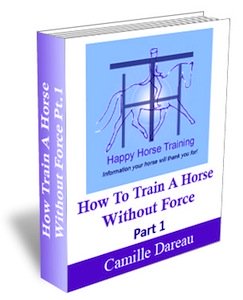| Back to Back Issues Page |
 |
|
The Whole Horse No. 30 - Equine Dentistry Effects October 14, 2013 |
The Truth About Teeth: Part 2Spotlight On Management
In the last year we have been discovering the importance of the length of a horse's incisors in relation to the rest of their teeth. Our teeth don't continue to grow throughout our lives in the same way as horse's teeth, so we don't necessarily intuitively understand the importance of balance in a horse's mouth. If the teeth surfaces start to lose alignment, as they often do as a result of uneven wear, then the horse will have less and less viable grinding surface with which to get the most value out of their food. The fact that horses are continually processing cellulose, a fibrous form of starch which is rigidly structured and requires a lot of chewing to break down, is another difference between them and us. It is, of course, the reason why their teeth are different from ours. Interestingly, horses' teeth do not grow in the same way as rodents' teeth, in that rodents continually produce the material of the teeth that grow throughout their lives. In fact, horses' teeth are already 'manufactured' early on, and as they wear down, the surfaces are gradually replaced by the continuous eruption of the teeth. Once they are used up, therefore, there are no more. This is another important reason to maintain good balance. Once a particular tooth is worn down more than others in the mouth as a result of lack of alignment, it will run out faster than the others. Overall, less tooth material is wasted when the whole mouth functions in the optimum balance. Considering that one of the main problems for horses in old age is the inability to chew food properly due to worn-out or missing teeth, this is an important concern for any horse-owner. This necessity for even wear is where the incisor question becomes particularly relevant. Their part in the overall balance is often neglected because:
What we have determined is that when the incisors become too long and uneven, it is as a result of uneven wear. Uneven wear is often because a horse has a favorite side for chewing food, which seems to mirror the handedness inherent in their bodies. Sometimes the favorite side will change as a result of other mouth issues (baby teeth failing to come out, fractured teeth etc.). As they grind more on one side of their jaw than the other, the diagonal nature of the grinding means that they wear down the opposite side of their incisors more, gradually setting up a pattern of misalignment, which begins to restrict the temporo-mandibular joint, affecting each side of it in a different way (see last month's Whole Horse Newsletter).
What we found was that almost all of the horses we studied prefer to chew on the side of their mouth that corresponds to the outside of their natural bend direction, i.e. if a horse is naturally right-bended, the chances are that he/she will prefer to chew on the left side of the molars, resulting in an incisor slant that goes upwards from left to right (from the horse's perspective). This dynamic means that the TMJ would be stretched open on the left side, and compressed on the right. This fits with the feeling the rider gets in the contact that the horse contracts into the concave side of the contact (the right side in this example), seeking to avoid the contact, and often feels heavy or resistant in the contact on the convex side (left side in this case).
Most people who study dressage training understand the importance of the horse's willing softening into the rein contact. This softening comes from the TMJ, as a knock-on effect of the activation of the ring of postural muscles and the longitudinal stretch. If the TMJ is held out of alignment by the unforgiving presence of the front teeth, then a true softening is impossible, and the movement will be coming up against a wall, no matter how sympathetic the riding.
The Effects on Training Over the weeks since our horses' incisors were reduced and balanced, we have been studying the changes in their ability to straighten and engage. There was an instantaneous improvement in all of the horses in terms of jaw softness and/or evenness. After a few sessions, however, we could feel just how profound the changes were going to have to be, and that it would them take a long time for these changes to integrate fully throughout their body. The best way to describe it is to imagine a plant whose roots have grown all bunched up in the pot. They have become dry and disorganized because they had no space to spread out into. If the plant is then planted out into the garden, because the space becomes available, the roots can begin to respond. It would take many months for such a plant to restructure its root system as if it had never been constricted in a pot. This is the same for the horse's readjustment process. In reality the whole body of the horse has to reconstruct itself to adapt to the change. Only then will the full potential of the new balance be realised. Rafael's progress is particularly interesting because he had always had excellent back teeth - no problem with eating or keeping his condition. The strange thing was that not only has he always been very complicated to ride, but most of the problems seemed to be amplified in his rein contact. He is a rescue horse of Spanish origin who was going to be put down because his previous owners couldn't ride him without being thrown off. Unknown to them, he actually turned out to be a 'rig' (Cryptorchid), resulting in high testosterone levels. Besides the way that affected his behaviour, he also has conformational issues and had previous bad training. His back was so hollow, and his his neck was so compressed that riding him was like sitting on a pneumatic drill! After many years of lunging and schooling he was making progress - his back was lifting and his paces had transformed. He also had a much better concentration span and was less evasive. There was, however, still an underlying resistance, expressing itself through mental tension and in certain physical 'habits', which wasn't resolving itself. I had considered having him properly gelded, because although he is happy and fulfilled with his own band of five mares, I wondered if this resistance was coming down to hormones. It didn't feel right to go through with it at any point though, and as things are turning out, that seems to have been the right decision! When Dan (our Equine Dentist) looked at his teeth from the 'incisor' point of view, the picture was very different indeed from the back-teeth-only perspective. In fact, he had a major imbalance in his jaw, which was being pushed left to such an extent that it was several millimeters off-centre. If you consider the leverage that a few millimeters at the incisor end of the jaw would have on his TMJ, it makes sense that he would not be at all comfortable at all in his work.
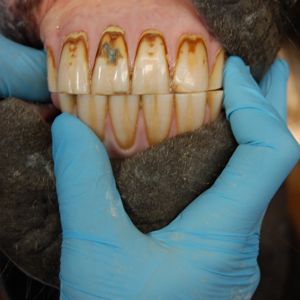
Incisors now balanced, with the jaw sitting how it wants to, - still misaligned because all of the supporting soft tissue is still in that pattern 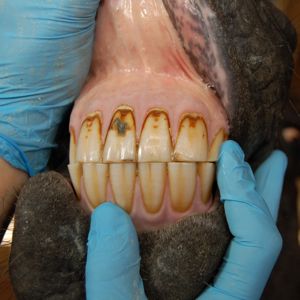
How the jaw should be when straight. It is now ABLE to sit like that, but time and training will be needed to make the correction in the nerves, muscles and connective tissues. In fact, since his incisors have been balanced it has been clear that he simply couldn't unwind his body. I was attempting to straighten his body in his work, and even though we never do this kind of work 'from the front end', it is necessary for the front end to be able to straighten in response, right down to the jaw softening on each side - otherwise the movement cannot flow all the way through. For poor Rafi, the movement was flowing up as far as his crooked jaw, and blocking there. Riding him now, after the block has been removed, it's very important, on one hand, to be patient and allow his body to re-adjust, but on the other hand to encourage his central nervous system to make new leaps, and to 'realize' that the block was no longer physically there. Sometimes he will literally leap in the air because he feels his whole front end able to lift and connect through, but the sensation is new to the ligaments and muscles. It seems like he feels that he is free but not yet liberated. It is like opening a stable door, but the horse doesn't yet know how to go out. What is particularly important, and does confirm what I have always believed, is that ALL of his behavioral 'evasions', as in thinking about dropping his shoulder, spinning back to the gate, losing concentration etc. simply evaporated, OVERNIGHT. Maybe they are not gone for good - it is early days - but in any case, he did those things because he felt physically frustrated. He felt caged by his body and he reacted accordingly. Horses do not behave in these ways because of psychological reasons, with the exception of those with post-traumatic stress disorder. Horses feel, they don't think. So if such behaviors persist, the physical source is still there. Imagine we had never discovered the incisor problem - Rafi would have been this way, at the root of himself, for the rest of his life.
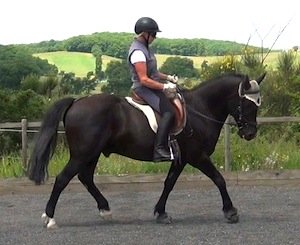
Before and after on the right right rein: this direction in the 'before' photo (right) shows the twist set up in his neck from the crooked jaw. This is his naturally concave side, so he has never been able to bend properly to the right. 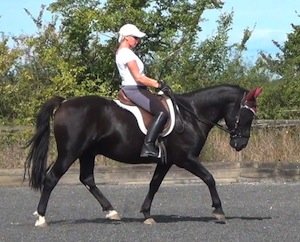
In the 'after' photo, although he is able to straighten his neck out of the twist now, he doesn't yet have the strength to raise his neck up very high. Also his poll flexion is still very weak, and some C3 flexion is still happening. The 'after' photo's were taken only weeks after the incisor reduction, so the improvement in a few years will be exciting to see! Horses Susceptible to Long/Unbalanced Incisors:
We have horses from all different backgrounds, and all of them have had excellent dental care of the back teeth. They all turned out to have long and/or unbalanced incisors. Although this could be partly due to the fact that we restrict their grazing (because the sugar content of grass is damaging for their feet), we strongly recommend that you have a look at your own horse or horses' incisors yourself, even if they graze most of the time.
HHT's monthly Try This At Home Tip Incisor Study You can analyse your own horse's incisor state and crookedness pattern in order to better understand any training issues, and to make sure they are not posing a problem or giving your horse discomfort. You are welcome to send in photos and information to the Happy Horse Training Facebook group for discussion (feel free to join if you are not already a member). If you are not on facebook and still wish to participate, just send us an e-mail: contact@happy-horse-training.com.
Plus the following information, if possible:
Just Click here to go to the HHT group page, and then click on the 'join group' button at the top right of the page.
Sharing the Holistic Message
If you enjoy Happy Horse Training and you find the information on the site useful, please help us to share it by clicking on the Facebook 'like' and 'share' buttons (if you have a fb account) that are on each page. Any other way you can pass the site on to friends and colleagues via, for example, discussion forums, is of course also greatly appreciated. You can also sign up to our RSS feed (blog) to be kept up to date with new ideas, pages and other information that we post there. Just click on the box that says 'subscribe to this site' at the left of each page. The equestrian world is one dominated by traditionalist ideas and conventions, but we like to think we can help inform the growing minority of horse-owners who want to make their horses happier with progressive and holistic methods.
Happy Horse Training now has over 100 pages exploring many different areas of holistic equitation. Do have a look through our site plan to find the subjects and categories that interest you.
Available from HHT:
New! The Gymnastic Rider eBook 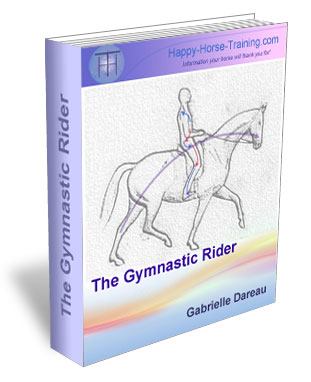 Available exclusively from HHT, a unique and comprehensive guide to practical rider biomechanics. This professionally produced eBook takes the rider through the process of developing their body in the specific way that brings the horse's movement into harmony and balance, without force and constraint.
Available exclusively from HHT, a unique and comprehensive guide to practical rider biomechanics. This professionally produced eBook takes the rider through the process of developing their body in the specific way that brings the horse's movement into harmony and balance, without force and constraint. The information in this book, including over 55 000 words, represents what we would normally pass on in a minimum of 12 specialist lunge lessons, focusing on each part of the position and its influence on the horse, with a value of at least €450. The Gymnastic Rider is available for only €29.99. Click here for full details, and to download the 15-page introduction to the book for free.
How to Train a Horse Without Force eBook With your purchase you will receive a free bonus supplement on Horse Trauma - cutting edge insights on this subject that up until now have mostly been applied only to human trauma. This supplement shows how to recognise, avoid and deal with horse trauma, which is much more common that we realise. These two e-books - How to Train a Horse Without Force and Horse Trauma comprise more than 75 thousand words and are richly illustrated. They are available for only 19.99 Euros (around $26). Click here for more details.
|
| Back to Back Issues Page |


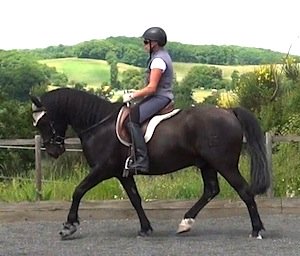 Before (photo left) and after (below) on the left rein: This rein shows the flexion at the third cervical vertebra, as opposed to at the poll, because he couldn't soften his TMJ, and therefore flex his poll. He is engaging in both photos (the correct diagonals prove that) but physically he couldn't flex his neck in the right place. Correct flexion is a result of RIDER engagement, which produces the horse's engagement, and depends on the horse being able to respond physically.
Before (photo left) and after (below) on the left rein: This rein shows the flexion at the third cervical vertebra, as opposed to at the poll, because he couldn't soften his TMJ, and therefore flex his poll. He is engaging in both photos (the correct diagonals prove that) but physically he couldn't flex his neck in the right place. Correct flexion is a result of RIDER engagement, which produces the horse's engagement, and depends on the horse being able to respond physically.
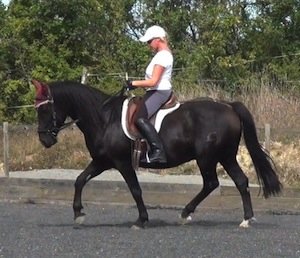 There is never a place for any form of 'fiddling' with the mouth or head carriage of a horse. When they CAN do it, they will - if we ride correctly and do our best to address their physical issues. If we hadn't discovered incisor reductions, we would STILL never try to correct the flexion with the rein or in any other way than better rider posture and aiding. Trying to influence the front end directly only ever creates more discomfort and negative associations for a horse, and certainly not a successful dynamic result.
There is never a place for any form of 'fiddling' with the mouth or head carriage of a horse. When they CAN do it, they will - if we ride correctly and do our best to address their physical issues. If we hadn't discovered incisor reductions, we would STILL never try to correct the flexion with the rein or in any other way than better rider posture and aiding. Trying to influence the front end directly only ever creates more discomfort and negative associations for a horse, and certainly not a successful dynamic result.
